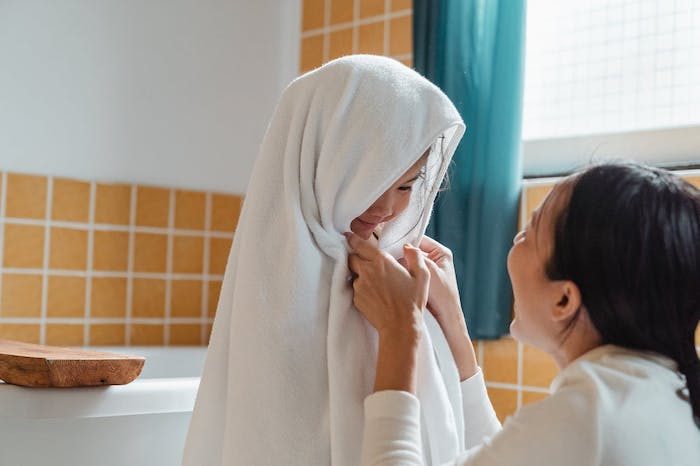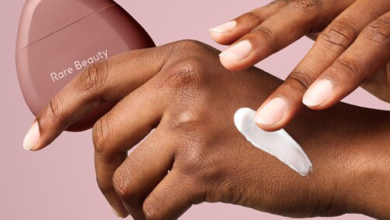Understanding and managing eczema in children: a quick guide

September is here, which means it’s Eczema Awareness Month – a crucial time to shed light on the challenges of eczema in children.
If your child is one of the millions of people affected by this common skin condition, you know that treating eczema can be a full-time job.
But you’re not alone. In the post below, we try to give you a better understanding of what eczema is, how it affects children, and what steps you can take to make your child’s daily life more comfortable.
What is eczema in children?
Atopic eczema – or atopic dermatitis – is a chronic inflammatory skin condition characterized by dry, itchy and inflamed skin. It is the most common form of eczema in children and often occurs before the age of five.
In babies, eczema usually occurs on the scalp, face and especially on the cheeks. The skin is dry and may show a scaly rash. Baby eczema can also appear on the elbows and knees. The skin may itch and in severe cases it may be raw or weepy. The symptoms can come and go.
When eczema develops in children between the ages of 2 and puberty, it usually starts as dry, flaky, itchy patches. Common areas include the folds of knees and elbows, in the navels and on the legs, neck, wrists and ankles. Over time, the skin can become thick and discolored, causing the skin to become chronically itchy.
What causes eczema is not yet well understood, but scientists know that a combination of genetic and environmental factors are involved. The Mount Sinai Health System states that certain genetic factors weaken the skin barrier – the outermost layer of the skin – allowing moisture to escape and bacteria and viruses to enter more easily.
Environmental factors can then cause eczema symptoms. For example, dust mites can cause the immune system to overreact, attacking skin cells and causing dryness and flaking. Allergens can also activate the immune system in the same way. This can include certain food ingredients, pollen, fragrances in personal care products and detergents, and more.
Eczema is often accompanied by other allergic conditions such as asthma, hay fever and seasonal allergies. Many children with eczema also have food allergies.
HealthyChildren.org adds that many children with eczema don’t have enough of an outer layer protein known as ‘filaggrin’. Filaggrin helps the skin form a strong barrier between the body and the environment. Without sufficient moisture, the outer barrier is weak and has difficulty retaining moisture or keeping out irritants.
What does eczema in children look like?
Children with eczema suffer from a variety of symptoms, including the following, which negatively affect their daily lives:
Discomfort
The persistent itching and irritation can be very uncomfortable and affect a child’s mood, sleep, and overall quality of life.
Sleep disorders
When eczema flares up, it can keep children awake with nighttime itching. This can lead to daytime sleepiness and behavioral problems.
Activity restrictions
Some activities, such as swimming or playing certain sports, can worsen eczema symptoms, making a child less likely to participate.
Daily vigilance
If exposure to certain foods, allergens or product ingredients triggers eczema flare-ups in your child, you may find yourself taking a vigilant approach to what he or she eats, does or uses. This can create a stressful lifestyle for both of you.
Social impact
Children with eczema may feel self-conscious about the appearance of their skin, leading to social withdrawal. This can affect their self-esteem and make them less at risk in social interactions.

Managing eczema in children: practical tips
Although there is no cure for eczema, some children will grow out of it naturally. Others will continue to have dry, sensitive skin as they grow up.
Either way, you can help your child by teaching him how to prevent and manage symptoms. We recommend the following steps.
Identify and avoid triggers
Your child’s eczema is likely to flare up in response to certain triggers. It may help to keep a diary for a few weeks. Monitor potential triggers such as certain foods, environmental factors or stress. Gradually narrow down your findings until you have a good understanding of the things that seriously affect your child’s skin, and then try to avoid these things as much as possible.
Bathe gently
Every time you wash the skin you risk losing its natural moisturizing oils. A child with eczema already has dry skin, so you want to carefully protect whatever moisture they have.
- Use gentle cleansers that are pH neutral, fragrance-free and moisturizing.
- Limit bath or shower time to 5 to 10 minutes or less.
- Avoid using hot water; lukewarm water is less likely to damage the skin.
- Pat the skin dry with a towel, do not rub.
- Always apply moisturizer immediately after washing and bathing.
Maintain a consistent skin care routine
It is essential to keep the skin hydrated. Use gentle, fragrance-free, soothing skin care products and use them often.
CV Skinlabs products are designed to relieve the symptoms of eczema such as dryness and itching, as well as red, irritated skin. All our ingredients have been rigorously tested for both safety and efficacy and are dermatologist recommended. The formulas are always free of chemicals and steroids and help reduce inflammation.
That means parents can feel good about using these products because they are safe for babies and children.
It is always helpful to teach your child a healthy skin care routine as it will help him develop good habits from an early age. But if your child has eczema, this is even more important. From the age of four or five, start with your child through a morning and evening care routine. Explain why this is important and describe the three basic steps: cleansing, toning and moisturizing.
Cleaning: Always use a gentle, creamy cleanser with lukewarm water. Consistently emphasize these important aspects of cleaning. Buy products together with your child. Explain which products are best for their skin and why.
Firming: This is a crucial step for children with eczema. Always avoid alcohol toners as they will further dry out your child’s skin. Use our Rescue + Relief Spray as it not only helps to balance the skin’s pH, but also hydrates and reduces inflammation, preparing your child’s skin to absorb moisturizer.
Moisturizer: Your child’s skin is drier than it should be, which means the outer barrier is being compromised. Hydration is extremely important in managing eczema symptoms. Teach your child to always moisturize immediately after washing, bathing and showering.
We recommend our fragrance-free Calming Moisture and Body Repair Lotion. They both contain anti-inflammatory ingredients and (gluten-free) oats that help soothe inflamed skin, along with ceramides, emollients like natural shea butter and oils that replenish moisture and help restore the outer barrier.

Avoid aggressive products
Consider your child’s skin as sensitive skin and treat it accordingly. That means you should always buy gentle skin care products, cleaning products, laundry products and clothes. Use hypoallergenic detergents and always avoid harsh soaps. Choose soft, breathable fabrics such as cotton and avoid rough or scratchy materials that can irritate the skin.
Create a skin-friendly home environment
Place a humidifier in your child’s bedroom to add moisture to the air, especially during the winter and year-round if you live in a dry climate. Do your best to keep your home cool, as heat and sweating can cause flare-ups.
Manage itching
Trim your child’s fingernails regularly to minimize damage or infection caused by scratching. Use our Rescue + Relief Spray for instant relief from itching and inflammation. It contains natural cooling ingredients that dissipate heat and hydrate on contact.
Treat painful areas immediately
If your child develops wounds from itching and scratching, treat them immediately. Cleanse gently and then apply our Restorative Skin Balm. It will create a protective barrier that retains moisture. It is a steroid-free restorative solution that instantly soothes and hydrates while encouraging faster healing and skin regeneration.
Encourage a healthy lifestyle
Your child’s skin condition depends not only on how you treat the skin on the outside, but also on how you nourish it from the inside. Teach your child how nutrition nourishes the skin and promote a balanced diet rich in anti-inflammatory foods like fruits and vegetables. Make sure you can always offer your child water and avoid sugary drinks that suck moisture from the skin.
Support emotional well-being
Encourage your child to talk to you regularly about how he or she is feeling. This allows them to open up to any negative experiences they may have regarding their eczema. If your child’s condition is significantly affecting his or her life, consider joining support groups or connecting with other families who are struggling with the same eczema symptoms.
Decide what is best for your child
Eczema behaves differently in some children than in others. Be patient and willing to try different approaches so you can discover what works best for your child. If you have any questions, consult your local dermatologist for help.
How do you deal with eczema in children?
Featured image by Ketut Subiyanto via Pexels.





